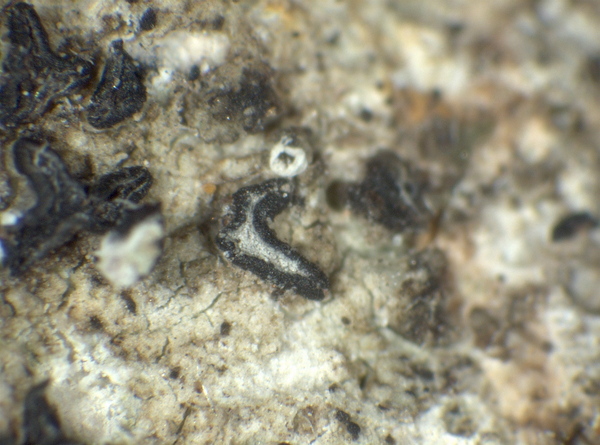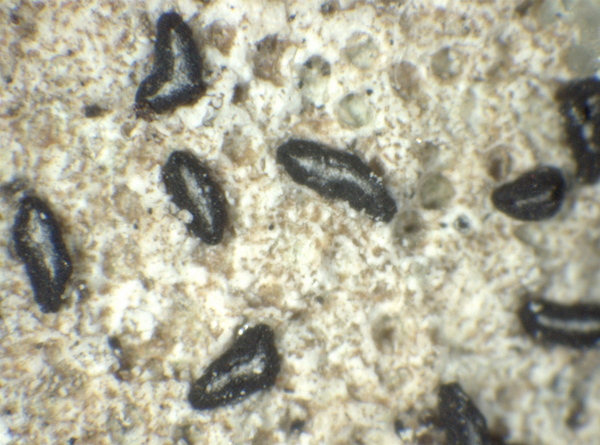Alyxoria subelevata (Nyl.) Ertz & Tehler
Fungal Divers., 49: 50, 2011. Basionym: Opegrapha subelevata Nyl. - Lich. Nov. Zeland.: 148, 1888.
Synonyms:
Distribution: N - Lig. C - Tosc, Laz (Genovesi & al. 2011), Abr (Nimis & Tretiach 1999), Sar. S - Camp (Nimis & Tretiach 2004, Garofalo & al. 2010), Bas (Bartoli & Puntillo 1998), Cal (Puntillo 1996), Si (Ottonello & Salone 1994, Grillo & al. 2009).
Description: Thallus crustose, endosubstratic or thinly episubstratic, smooth to finely rimose, whitish, yellowish white or grey. Apothecia lirelliform, emergent, 0.5-2(-3) x 0.2-0.3(-0.5) mm, scattered or crowded, elongate, usually simple, acute at ends, with an initially slit-like, then clearly expanded, densely bluish-white-pruinose disc, and a thin, raised, black, usually epruinose proper margin. Proper exciple brown-black, carbonized, extending below the subhymenium, K-; epithecium brown; hymenium colourless, 70-90(-100) μm high, I+ reddish; paraphysoids septate, branched, often richly anastomosing, 1.2-1.5 μm thick, the apical cell not or only slightly swollen; subhymenium pale brown, c. 20 μm high; hypothecium black, carbonized, continuous with the exciple, 30-55 µm high. Asci 8-spored, cylindrical-clavate, the inner layer of endoascus amyloid in upper part, with a I+ blue ring visible around a small ocular chamber, Varia-type. Ascospores 3-septate, hyaline (often brownish when overmature), ellipsoid to fusiform oor slightly clavate, straight to slightly curved, (16-)19-23(-27) x (5-)6-7(-8) μm, thick-walled, with a 1-1.2 μm thick gelatinous sheath. Pycnidia black, immersed. Conidia bacilliform, straight or slightly curved, 4-6 x 0.7-1 μm. Photobiont trentepohlioid. Spot tests: K-, C-, KC-, P-, UV-. Chemistry: without lichen substances.Note: a mild-temperate to Mediterranean-Macaronesian lichen found on calcareous or basic siliceous rocks (incl. lava), sometimes on mortar walls, mostly near the coast, mainly Tyrrhenian in Italy.
Growth form: Crustose
Substrata: rocks
Photobiont: Trentepohlia
Reproductive strategy: mainly sexual
Most common in areas with a humid-warm climate (e.g. most of Tyrrenian Italy)
Commonnes-rarity: (info)
Alpine belt: absent
Subalpine belt: absent
Oromediterranean belt: absent
Montane belt: absent
Submediterranean belt: very rare
Padanian area: absent
Humid submediterranean belt: rather rare
Humid mediterranean belt: very rare
Dry mediterranean belt: absent

Predictive model
Herbarium samples


P.L. Nimis; Owner: Department of Life Sciences, University of Trieste
Herbarium: TSB (14511)
2001/11/27


P.L.Nimis; Owner: Department of Life Sciences, University of Trieste
Herbarium: TSB (38300)
2008.02.23
Growth form: Crustose
Substrata: rocks
Photobiont: Trentepohlia
Reproductive strategy: mainly sexual
Most common in areas with a humid-warm climate (e.g. most of Tyrrenian Italy)
Commonnes-rarity: (info)
Alpine belt: absent
Subalpine belt: absent
Oromediterranean belt: absent
Montane belt: absent
Submediterranean belt: very rare
Padanian area: absent
Humid submediterranean belt: rather rare
Humid mediterranean belt: very rare
Dry mediterranean belt: absent

Predictive model
| Herbarium samples |


P.L. Nimis; Owner: Department of Life Sciences, University of Trieste
Herbarium: TSB (14511)
2001/11/27


 Index Fungorum
Index Fungorum
 GBIF
GBIF





